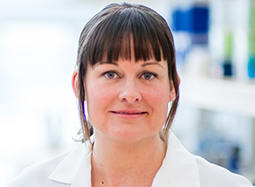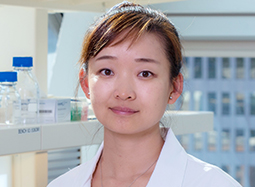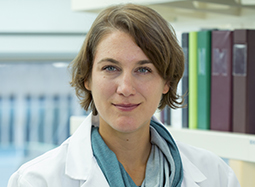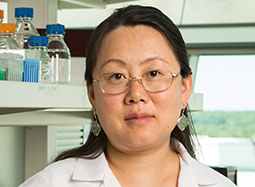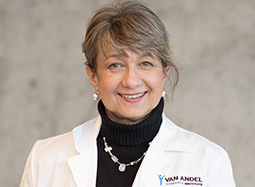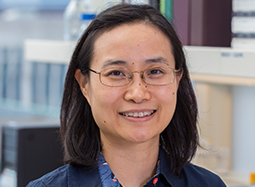Strength through diversity
September 9, 2018

Rigorous science, boundless creativity and diversity of thought are critical elements of a successful research enterprise.
Van Andel Research Institute (VARI) is committed to fostering an environment that encourages excellence and is proud of its growing team of women faculty. Together with their collaborators in the U.S. and abroad, VARI scientists are discovering new ways to solve some of today’s greatest health challenges.
In this month’s edition of Highlights of Hope, we celebrate their outstanding work and, below, we delve a bit deeper into what they think are the most exciting things happening in their fields and what gives them hope for the future.
Depression affects more than 300 million people worldwide, and more than 800,000 lose their lives to suicide each year. As a psychiatrist and a scientist, Dr. Lena Brundin searches for better ways to diagnose and treat these serious public health concerns by studying inflammation of the nervous system and translating her findings into new approaches to diagnosis, monitoring and treatment.
What is the most exciting thing happening in your field?
I am hopeful that one or several of the anti-inflammatory medications that are already in clinical use can actually be used to treat depression and suicidality. I think there is a growing awareness among doctors and patients that depression and suicidality might be triggered by inflammatory factors. The next steps are to develop good diagnostic methods and to treat the patients!
I also am excited that we are beginning to see studies analyzing blood samples for psychiatric patients, trying to pre-select people with signs of inflammation for specific clinical trials targeting these mechanisms. I am also excited to see several clinical trials are utilizing novel anti-depressive treatments that change glutamate neurotransmission and may counteract the effects of inflammation in the brain, including ketamine and AV-101.
Dr. Juan Du
In biology, the structure of a molecule is directly linked to its role in the body. Using the Institute’s high-powered cryo-electron microscope (cryo-EM), Dr. Juan Du is working to understand the brain’s intricate communication system by visualizing its smallest components, which she hopes will inform the development of new therapies for neurological diseases.
What is the most exciting thing happening in your field?
The most exciting thing happening in my field — structural biology — is the resolution revolution in cryo electron microscope (cryo-EM). The fascinating developments and breakthrough of single particle cryo-EM in both hardware and software allow us to determine the structures of macromolecules at near-atomic solution and capture their different functional states quickly. This is a really exciting moment for all the structural biologists.
We aim to understand how the neuronal ion channels function and hope to use our cryo-EM ion channel structures as a basis and guide to develop specific drugs to treat neurological diseases.
Parkinson’s disease has long been considered to be a movement-related disorder triggered by changes in the brain. Now, growing evidence shows that other parts of the body, including the gut, may play a major role in its onset and could provide new opportunities for prevention and treatment. Dr. Viviane Labrie is working to develop these new therapeutic strategies by studying the complex web of factors that give rise to Parkinson’s in hopes of finding innovative ways to slow or stop its progression — something no current treatment can do.
What is the most exciting thing happening in your field?
The research aimed at understanding the origins of Parkinson’s disease is rapidly shifting beyond a brain-centric view to encompassing areas outside of the brain like the gastrointestinal tract. This has led to a merging of many fields in biology including immunology, gastroenterology, genetics/epigenetics, microbiology, along with neuroscience. We are seeing the opening of many new doors to understanding Parkinson’s, and it is really interesting to think that the disease could start in the gastrointestinal tract and eventually spread to the brain. What gives me hope is that gastrointestinal tissues, which are much easier to access than the brain, could one day be used for early diagnosis and treatment.
Dr. Xiaohong Li
Once cancer spreads to the bone, it becomes much more difficult to treat and much more painful for the patient. Dr. Xiaohong Li studies how and why certain cancers — such as those in the breast, lung and prostate — are more likely to migrate to the skeleton in hopes of finding new ways to stop this process and to treat these aggressive cancers.
What is the most exciting thing happening in your field?
There are many exciting things happened in cancer research. The most exciting one in technology is CRISPR-Cas9; in treatment, it is immunotherapy; and in research direction, it is a better understanding of tumor dormancy and residual disease. Because of these exciting advances and progress, I believe that, in the near future, we will be able to prevent and/or cure cancer metastases and recurrences, which cause more than 90 percent cancer-related deaths.
Dr. Hui Shen harnesses the power of Big Data and cutting-edge computational methods to investigate the interaction between genes and their epigenetic control systems in pursuit of new ways to prevent, diagnose and treat cancer. She is particularly interested in women’s cancers, with a focus on ovarian cancer, but is also interested in commonalities shared between different kinds of cancer.
What is the most exciting thing happening in your field?
The most exciting thing is that we are gathering an unparalleled amount of information about human cancers with fast advancing genome-scale molecular technologies. These “reference maps” are extremely helpful for devising new therapeutic strategies and guiding clinical trials.
Dr. Piroska Szabó studies the flow of hereditary information from the parents’ DNA to their offspring, with a focus on the “epigenetic memories” that inform development. Slight alterations to these “memories,” which are manifested as tags that are added to the genetic code, have lasting consequences on health and disease risk that last throughout a person’s lifetime.
What is the most exciting thing happening in your field?
Retroviruses have made a home in our DNA and occupy a large part of our genome. It is becoming clear lately that, despite the dangers they pose, we can’t live without these parasites. They are, indeed, essential to human reproduction. Early embryo development cannot proceed without the expression of viral proteins and early mammalian genes need viral regulatory elements for their activation. To keep them in check, endogenous retroviral expression has to be activated in the early embryo but has to be suppressed soon after activation. Studying the molecular mechanisms of retrovirus regulation is a very exciting research direction these days and our laboratory is currently testing the role of specific molecules in this process.
Dr. Hong Wen
Epigenetic changes impact how the instructions in our DNA are carried out, making them a key player in cancer development, progression and resistance to treatment. Dr. Hong Wen and her team are working to understand how cancer cells, particularly in pediatric cancers, exploit epigenetic processes to activate genes that cause cancer and to silence those that suppress the development of the disease. Ultimately, they hope to translate their findings into improved medications that correct these processes when they go awry, better treating cancers and enhancing the lives of patients.
What is the most exciting thing happening in your field?
The most exciting thing happening in the cancer epigenetics field is the identification of a large number of genetic mutations in genes encoding epigenetic regulators in human cancers by high-throughput gene sequencing. We now know that as few as just one genetic alteration of these regulators can lead to cancer, such as MLL gene translocation in leukemias in children. Although we are still far from a clear understanding of the molecular mechanisms underlying these cancer mutations, I believe that targeting these alterations, along with other therapies, will bring us hope for cancer treatment for the future.
Many human diseases, including diabetes, neurodegeneration and cancer, are linked to cellular damage that accrues as we grow older. Dr. Ning Wu aims to find new ways to prevent or slow the onset of such diseases by better understanding how altering one’s diet and, therefore, metabolism may delay the effects of aging.
What is the most exciting thing happening in your field?
Watching the next generation grow up is tremendously exciting. Additionally, scientists from different fields are now realizing the importance of metabolism — both on the cellular level and on the whole organism level — to the disease systems they study.

